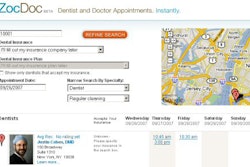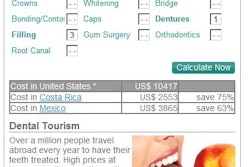
SAN FRANCISCO - Nearly half of all Americans don't visit a dentist regularly. Why are they avoiding you? To find out, the American Dental Association recently surveyed some of those people. The top reasons they skip the dentist's chair: cost and a previous bad experience (and with the latter, the worst experience was dealing with unfriendly staff). Other reasons: not knowing a good dentist, not having enough time, and of course, fear of pain.
That's why dentists need to assess their "broken windows," said Cathy Jameson, a dental practice management and marketing coach from Oklahoma City, who addressed the topic in her presentation, "Marketing Your Services in Your Community," at the American Dental Association annual session in San Francisco. Her session was sponsored by CareCredit, a GE Money Company that offers patient payment plans for procedures not covered by insurance.
Jameson was alluding to the book "Broken Windows, Broken Business" by Michael Levine. Levine uses the "broken window" theory from criminologists -- that neighborhood upkeep and reducing petty crime enhances the livability of an area and reduces more violent crimes. In business, the broken windows that turn customers off could be as simple as poorly maintained restrooms. Dentists need to focus on these seemingly small matters as the cornerstone of good marketing practices, according to Jameson.
"If I walk into a dental office and see stains on the carpet, I'd think that if they can't take care of their surroundings. How good are they at sterilizing equipment or providing the best dental care? Dentists need to meet with their team and ask if [the practice] has any broken windows."
Assessing this is a matter of taking the patient's point of view, from driving up to the front door to checking out the reception area. Is it neat, clean, well-groomed? Then check office practices. Are appointments scheduled properly and on time? Is the technology the office uses up to date? Impressing current clients -- generating good word of mouth -- is the cornerstone of marketing, since referrals are the leading source of new patients. "People's perception of quality of care often comes from everything but the dental care itself," Jameson said. "You need to fix the glitches -- i.e., the cracks in your window, before you can start an external marketing program."
Your marketing plan
The next step is developing a strategic marketing plan. First, answer these questions:
- Who are we? What image or message do you want to convey?
- What are we about? What methods will you use to benefit clients?
Then you need to create a five-step plan with concrete goals:
- Create the goal itself (e.g., "I want to increase new patients by 10 a month,").
- Design a plan of action -- how do we do that? What resources you do you need to do it? Who will focus on it?
- Assign specific responsibilities to staff.
- Set milestones to meet.
- Evaluate your progress at regular intervals to see if you're meeting your goals.
What patients want
One way to determine what your goals should be is to ask patients what they like, dislike, and want more of. A few ways to get their opinion are:
- Patient surveys: A profession survey company can create targeted surveys that tell you what clients are pleased about and what they don't like, Jameson said.
- Questionnaires: You can do these in-house. For frank disclosure, have patients fill out the questionnaire anonymously.
- Focus groups: Hire a marketing professional who knows how to run a group and knows what patients to pick. Don't just pick your favorite clients, Jameson warned. Get a variety of patients for more honest results.
- Smile evaluations: Ask patients to evaluate the care you've given them. Was the appointment convenient? Are you happy with your smile? Did you experience any discomfort? What would you like to change about your teeth?
- Ask for referrals: Have someone on the staff be responsible for directly asking patients for referrals. "Do you have friends, family, or colleagues who need new dental care? We'd love to take care of patients as good as you are." Then give them some cards to hand out.
Marketing to current clients
An acceptable amount to spend on marketing costs is 1% to 3% of your revenues, Jameson said. If you are renovating or expanding services, 4% to 6% is a good number.
Keeping good relationships with current patients is key for two reasons, she said. First, doing so will boost their word of mouth about you and thus generate referrals. Second, as cosmetic dentistry becomes more popular, you can offer them services beyond fillings and crowns.
One way to keep in touch is with regular print or online newsletters. Likewise, consider special mailings of articles about new advances in dentistry. It goes without saying that a Web site is a key marketing tool, but you should refresh it with new information to keep patients (and prospective patients) coming back regularly.
Jameson recommended touching base with clients once a quarter. "If the only time they hear from you is when they owe money, that's a broken window. Communicate well, positive news. Tell them what's happening in dentistry and what you're doing to stay on top of it."
Reaching out to the public
A brochure is a classic and still essential marketing tool, Jameson said. "Patients may be sitting in your chair saying, 'I read about teeth whitening in Vogue," or "Can you recommend where I can go to get veneers?"
Your brochure should have:
- A professional-looking logo and consistent color scheme (which should go on every marketing piece you send out)
- Your mission statement
- Benefits of the services you offer
- The doctor's photograph and bio
- Hours, address, and map
"It should be attractive, to the point, encouraging, and classy," Jameson said. Besides mailing brochures out with continuous care reminders, leave them in the reception area and put them on your Web site.
When current patients' referrals start rolling in, send a welcome packet to the new clients. It should include your brochure, latest newsletter, health history form with a self-addressed stamped envelope, appointment card, and financing information. "Do some 'preheating' by developing a relationship with them before they walk in your door," Jameson said. "[Patients] knowing something about you beforehand reduces the number of no-shows and cancellations."
Ambitious to reach further afield? Consider media exposure in newspaper, radio, TV, and magazines. But hire a professional to help you develop a great message and the best possible advertisement. You should also dedicate someone on staff who is trained in handling referral calls from these sources. "A person calling you after seeing an ad in Elle needs to be converted differently than a referral from a 20-year patient."
Finally, network, network, network. Appearance specialists such as plastic surgeons, dermatologists, fitness centers, and dental specialists can spread the word about the advanced services you offer, but you need to woo and educate them first, Jameson said. "You must be proactive; take them out to lunch or drinks. Even most physicians don't know what can be done in dentistry today, so be the one to tell them."
Why market if you're already have a full patient load? Jameson's rebuttal: There's never a time when you should not be marketing. "The time to market yourself most is when you're on top. To get current patients using more services and new patients coming in, you need to keep on it. There's no such thing as status quo."
Copyright © 2007 DrBicuspid.com

















